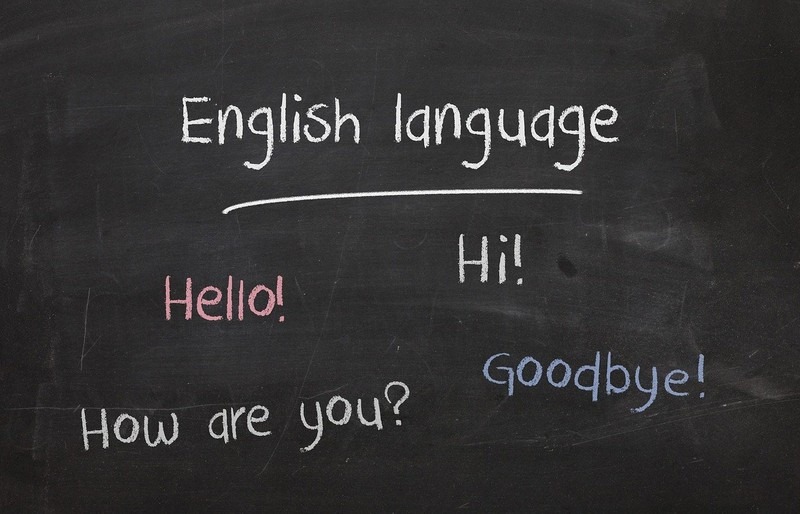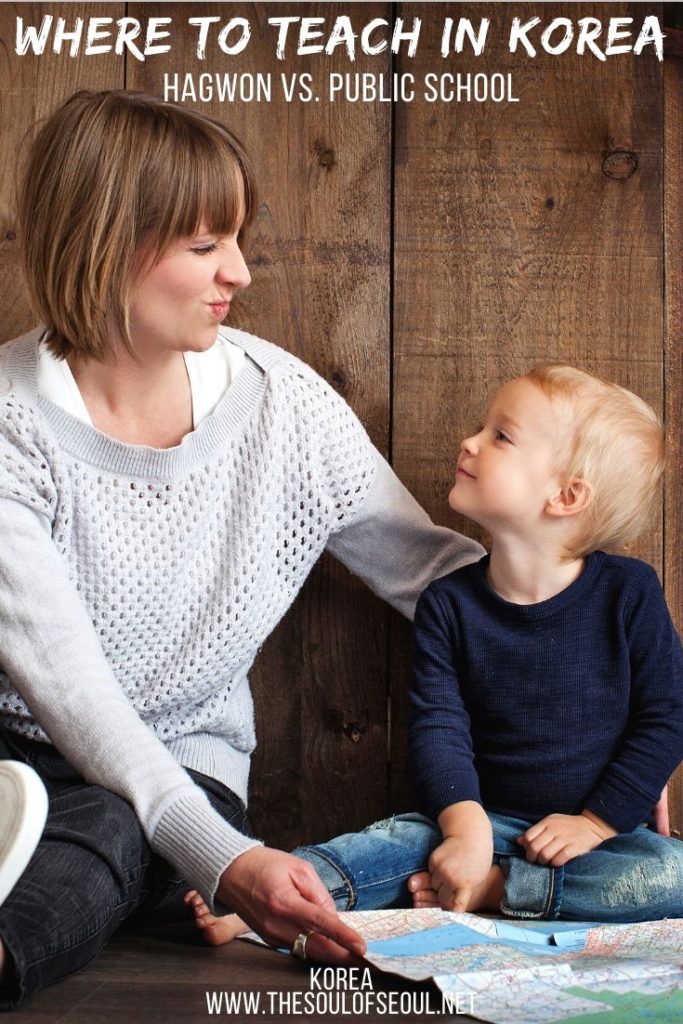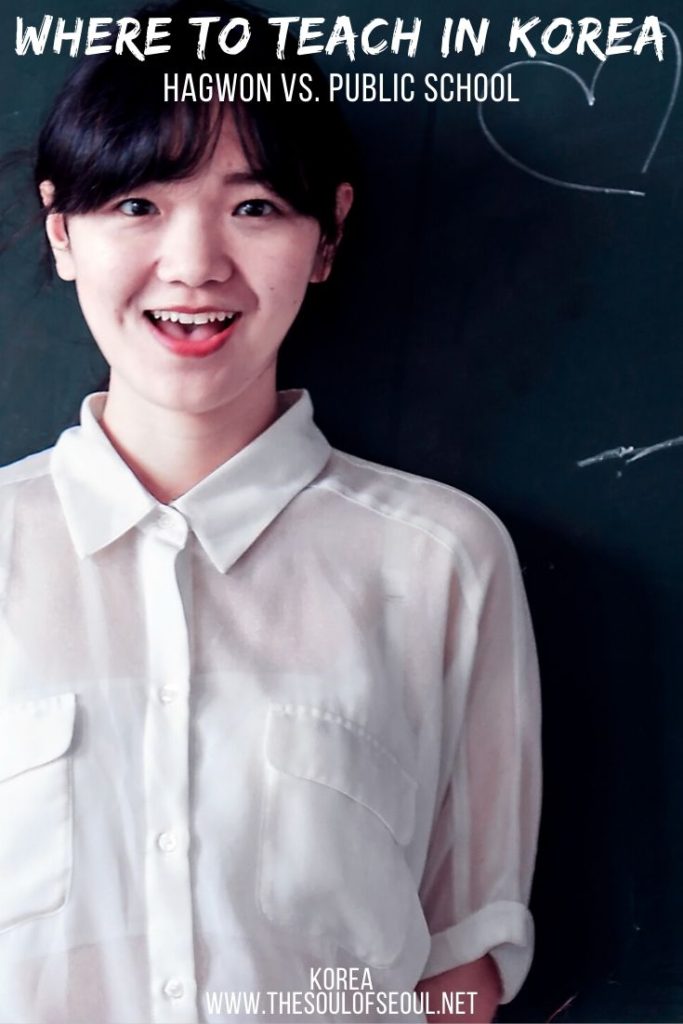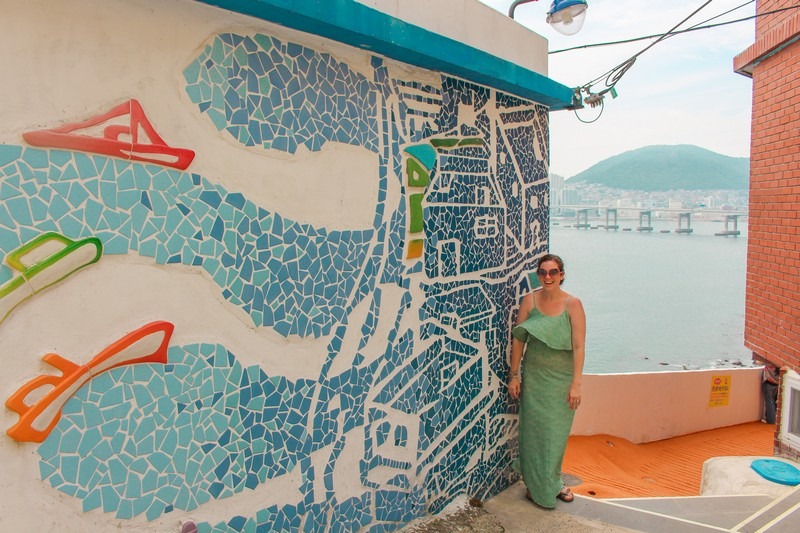Hagwon VS. Public School: Where To Teach In Korea
Last Updated on July 5, 2023
When people decide to teach in Korea, there is often a misunderstanding between a hagwon vs public school. It’s definitely a different system than most people around the world are used to.
In America, we go to school and do our extra curricular or tutoring usually within the school. In Asia however, the education system is way more rigorous than Western countries. Here, kids go to school in the morning, then in the afternoon, most of them go to academies till 10pm or later. These academies, called hagwons in Korean, are essentially programs for extra practice and tutoring. Whereas public school is the place all students are required to attend by law as with most places around the world. There are a lot of differences between working in a hagwon vs. public school.
This post will cover the key differences between hagwons and public schools in Korea and help you decide which is the best fit for you. There are pros and cons to both the hagwon system and the public school system in Korea so make sure you assess each thoroughly before you begin applying. Once you’ve decided which place is for you, then check out this guide for getting a teaching job in Korea.

Feel free to skip around to get the details:
- Benefits of Teaching In South Korea
- Korean Hagwon Or Academy Jobs
- Korean Public School
- Which Is Best?
(This post contains affiliate links, which means I receive a certain percentage of a sale if you purchase after clicking at no cost to you. Thank you for your support.)

Benefits of Teaching In South Korea
Many people think that teaching abroad is impossible, I mean, who has the money for that? I used to be the exact same way thinking I’d need a crazy amount of savings to uproot my life at home and move abroad. Believe it or not, teaching abroad doesn’t have to break the bank at all Actually, you can save a lot of money and pay off those student loans if you need to as well. You can seriously benefit from teaching in South Korea, and here’s why:
- Housing is Provided
- A Round Trip Flight or Flight Reimbursement is Provided
- Visa Sponsorship is Through the School
- The cost of living is much lower than most Western countries; which means you have more disposable income, people can even pay off their student loans here! If you need to send money home for payments or just savings, SentBe is the best option around.
- Traveling around Asia is relatively cheap
- Offers one of the highest salaries in the TEFL market
- Medical insurance (going to the doctor here doesn’t cost you your life)
- A TEFL certificate makes it easier for you to get a job here, but it’s not an absolutely essential.
Korean Hagwon or Korean Academy Jobs
As previously mentioned, a hagwon is a place for extra practice and tutoring. Children often attend these programs after school if they’re elementary to high school age. However, kindergarten jobs are also available for foreigners and the information is the same so know that you would likely be teaching students that range in age from kindergarten to high school.
There are many different hagwons that parents can send their children to from math, music, and taekwondo, to English. They also pay a lot of money for the tuition to these private academies which means that often parents are more involved and will have more say in what is happening because they’re paying for it.

Basic Information
Requirements:
- A valid passport from one of seven countries including: US, Canada, UK, Ireland, South Africa, Australia, or New Zealand.
- A bachelor’s degree from an accredited institution in any subject. Make sure you get the apostille on it as well. (You do not have to have an English degree or related to teach English in Korea.)
- A background check with a clean record (Traffic violations aside, you’ll be hard pressed to get a job in Korea if you have any charges or convictions against you.)
- A clean health check
- (Optional) TEFL certification.
Hiring Period: Year Round.
Salary: 2.1-2.5 million Korean Won is the average pay for a foreign teacher at an academy
- Note: the exchange rate may change throughout the year but most people will say W1,000 = $1.00 on average so keeping that in mind, you can make $2,100 – $2,500 per month.
- This salary is on top of the provided housing and airfare so the only thing that comes out of this is taxes, basic utility payments, and Korean National Pension payments so you’re taking quite a bit home.
Benefits: There are some important things that you want to make sure are in your contract before you sign. Because of the nature of hagwons and that they are privately owned, owners can play dumb or purposefully leave things out and it’s up to you to make sure everything is included that needs to be. I’d like to emphasize the severance and pension. These aspects of your contract are crucial. If they are not included in your contract, run, it’s illegal.
- Flight reimbursement (2 weeks after you arrive),
- Housing or Housing Allowance
- Medical Insurance (Your school pays 50% and you pay 50% of the payment.)
- Severance pay (An additional month’s pay after the completion of a full year.)
- Pension (Your school pays 50% and you pay 50% of the payment.)
- Bonus pay for contract completion, contract renewal/extension
- Not in the contract, but one benefit of a hagwon is that you will likely be working with other foreigners. It’s an easy built in community right away.
Hours: Hours vary depending on the age of students. On average, academy teachers have a 40 hour work load but are in the classroom for 30 hours of that time. Although some schools will have you teach 25 hours and the rest of the working period is dedicated to administrative work such as grading and paperwork. In general, academies require the teacher to be in the classroom for more hours than public school.
- For Kindergartens: Monday – Friday: 9:00am ~ 5:00pm OR 11:00am ~ 8:00pm
- For Elementary to High School Students: Monday – Friday: 1:00pm ~ 8:00pm OR 2:00pm ~ 10:00pm
- For Adults: There is a “split shift” schedule allowing for adults to work. There is an AM shift usually from 6:00am ~ 10:00am and then an afternoon shift from 6:00pm ~ 10:00pm*
- This schedule looks quite great if you want to get out during the day but it can be pretty grueling so these contracts are often offered for just 6 months at a time and the schools will rotate teachers so they work a more “standard” schedule for half of the year and the split shift for half of the year.
Class size: At a hagwon, you are the sole teacher in the classroom. Some bigger hagwons do provide Korean assistant teachers to serve as translators or have a disciplinary role. The typical number of students for an academy class is 8-10 at the most. At my school, my largest class is 8 students which is great, especially for your first teaching job. The classes are kept small for more one-on-one education opportunities.

Lesson planning: Hagwons generally have a curriculum that they operate on. The books and supplies are already provided for you. At my hagwon, the lesson plans are already made with the page numbers for that day. It is simply up to me as to how I want to teach it. Therefore, you won’t have any stress about what to teach the students.
That is generally speaking as some hagwons give their teachers more freedom to choose the books they want to use and plan the entire class syllabus from beginning to end. Make sure to ask teachers currently working there how it works at the school you’re applying to.
Administrative work: This is one area I want to emphasize for anyone interested in teaching in Korea. At a private academy, the homework grading is 80% of the job. You have to keep up with testing and other paperwork for every class you teach. Many hagwon jobs will require that you give a monthly test and throughout the year write “report cards” or summaries that the school can pass on to parents.
Vacation days: A hagwon only gives a total of 10 vacation days, 5 in the summer and 5 in the winter in addition to the public holidays of South Korea.
Sick days: A private academy is legally supposed to give you 2- 3 sick days but it’s up to you to get them. While they are legally required, most hagwons don’t have any system for substitute teachers so if you try to stay out for a day or two, they will make you feel very guilty about it. Koreans are known to work while sick and work hard. So be prepared for this mentality when you come.
Training: This will last a period of 5 days. You will have the chance to shadow a seasoned teacher for that period. They will explain the system that the school operates on both curriculum and disciplinary wise. It gives you a chance to familiarize yourself with the learning materials provided. And sometimes on the last day of training, whoever you are shadowing will give you a chance to maybe teach a class or two. Remember that just as you were not required to have any teaching experience to obtain this job, likely the person you’re shadowing was not either. Get the ins and outs of the school from this person and pick up any details about students that you can before your training teacher, who is likely the teacher you’ll be replacing, is leaving.
Student levels: In a private academy, students are generally placed into classes depending on their level. Obviously students learn in different ways and paces. But having students at the same level makes teaching a lot easier. I say “generally” because often friends will sign up together or one parent will get a couple other parents to sign their kids up because the first parent will get a discount on the fees and then the school may place all of the kids together in the same classroom because they’ve basically paid to be together. Remember hagwons are a business and the owners may not be completely devoted to teaching for the sake of teaching.
Korean Public School Jobs
Korean public schools are much like public schools around the world though the job for an ESL teacher will have some key differences from a hagwon to a public school. In a public school, there is a more rigid hierarchy and the ESL teacher is generally not hired directly by the school but by the Metropolitan Office of Education which means if anything happens at the school, you should be in touch with your handler at the office of education and not directly with those at your school though you will also have one teacher at your school who is designated as the person to go to with issues or questions. The system is a bit different but the public school job can be quite comfortable.

Basic Information
Requirements:
- A valid passport from one of seven countries including: US, Canada, UK, Ireland, South Africa, Australia, or New Zealand.
- A bachelor’s degree from an accredited institution in any subject (You do not have to have an English degree or related to teach English in Korea.)
- A background check with a clean record (Traffic violations aside, you’ll be hard pressed to get a job in Korea if you have any charges or convictions against you.)
- A clean health check
- TEFL certification OR Teaching License. Unlike hagwons, it is a requirement to have this for public school positions.
- You can get a certificate online easily with ITTT (<– You can get a 15% discount if you click that link). I used this option since I was already living and working in Korea.
Hiring Period: There are only two intakes per year: Spring and Fall. If you’re hoping to get into the spring intake, you should submit your application 6 months prior to March 1st. If you want the fall intake, you should submit documents 6 months prior to September 1st.
Salary: 2.0 – 2.7 million Korean won
- Note: the exchange rate may change throughout the year but most people will say W1,000 = $1.00 on average so keeping that in mind, you can make $2,000 – $2,700 per month.
- The public school system has a pay scale established and the first tier requires a Bachelor’s degree + some form of accreditation including a TEFL or Teacher’s License to obtain the job. You can move up in payscale either by renewing your contract or by increasing your level of education.
- This salary is on top of the provided housing and airfare so the only thing that comes out of this is taxes, basic utility payments, and Korean National Pension payments so you’re taking quite a bit home.
Benefits:
- Settlement Allowance of W300,000 (A one time payment)
- Flight reimbursement
- Housing OR Housing Allowance
- Pension (Your school pays 50% and you pay 50% of the payment.)
- Severance (An additional month’s pay after the completion of a full year.)
- Medical Insurance (Your school pays 50% and you pay 50% of the payment.)
- Renewal Bonus of W700,000 upon completion of the contract and re-signing for another year. (Only offered in provinces outside of Seoul.)
Hours: Currently, foreign teachers are only being hired to work in elementary schools so that is the only age to teach for these jobs. This job requires you to be at the school for 40 hours a week but on average teachers are only in the classroom for 22 hours a week so there is ample time for preparation.
- Elementary Schools: 9:00am ~ 5:00pm*
- Note that this is for the standard school day. There is a month vacation in the summer and another month in the winter and during those times there is an adjusted schedule. Each school can be a bit different but generally, you’d teach a camp for two weeks to students that sign up from 9:00am ~ 12:00pm and then you can go home.
- HOWEVER, if there is no camp, you are still required to sit at school as mandated by the office of education and NOT by your school which means that you may be asked to “deskwarm”. This means that you need to fill that seat for a specific number of hours even if no one else is in the school in order to fulfill your contract.
- Just a note that not all schools will have you do this. It’s really up to your care teacher and they may tell you just not to come and waste the heat but then it’s a bit of a “I won’t tell, if you don’t tell” situation. Just cross your fingers you get a good handler teacher.
Class size: On average, there are 25 – 30 students in the classroom when you’re in a city school (there may only be 10 when you’re in the countryside classrooms) however unlike hagwons, there is always a Korean co-teacher on hand. The Korean co-teacher is required by law and they generally help facilitate and direct the room though it’s up to ever Korean and foreign partner teacher to establish a partnership in the classroom.

Lesson planning: In principle, the foreign teacher is teaching in collaboration with the Korean teacher so using the book that is mandated, the Korean teacher and English teacher usually divide the pages so that the foreign teacher covers the speaking section. Unlike hagwons, the foreign teacher is responsible for preparing all syllabus and lesson plans for classes using the assigned text book.
Administrative Work: Generally, there isn’t homework assigned which means there isn’t homework to grade. Tests are also generally taken with the Korean teacher though there may be a speaking portion that the foreign teacher can cover. In this case however, it’s a pretty simple check, check, check hand it off to the Korean teacher situation as the Korean teacher will handle the administrative duties as far as inputting grades into the system, etc.
Vacation days: This is one area where the public school and private academies differ. In public school, you get 4-weeks of vacation plus all Korean national holidays. This is great for anyone who wants more time to travel. It may actually be more as well depending on the school schedule and various camps and how the Korean co-teacher feels. If you have a co-teacher who doesn’t feel the need to have you deskwarm, you’re still technically required to be in the country, but you could travel in Korea and it’d be fine.
Sick days: Depending on what program you do or where you work, this can range from 7-11 days. Because there is a Korean co-teacher that is always in the class, having a sick day means that you do have a substitute available to you. To be honest, you don’t want to try and use ALL of your sick days because Koreans don’t just do that, but if you do have a situation, it’s easier to take a sick day at a Korean public school than it is at a hagwon.
Training: There is a training week where all of the new public school teachers are gathered at a local university to learn about Korea, culture, some classroom information and duties, but the main thing to do here is to meet the other foreign teachers. At most hagwons, you are NOT the only foreign teacher so you have a built-in community right away. At public schools you WILL be the only foreign teacher at the school so it’s important to use the training week to meet others.
Student levels: In public school, students are all put in the same class dependent upon age so levels will vary. I think this makes teaching more difficult in a sense. As you have to be able to read your audience and balance where to put more emphasis on. Put like most TEFL training and teaching training will tell you, you want to teach to the middle and all students to speak more or less. Since foreign teachers cover the speaking portion of class, it’s a lot of listening and repetition and there’s ample opportunity to let students speak more, or less and listen to others.
Which Is Best?
There are pros and cons to both work conditions. A con of hagwons is that it can be hit or miss because they are private entities. If the school goes out of business, you’re out with no recourse. That would never happen at a public school. Public schools are great… unless you’re not a morning person and then it might not be a good fit for you. Public schools can be lonely for new foreigners in Korea because there are no other foreign teachers on the premises while hagwons may have 3 to 10 other foreigners on staff.
With housing, flights, and severence and pension provided by both along with medical insurance, it’s somewhat small differences between the two situations. Would you prefer to teach your own classroom and have all of the control? Then maybe hagwons are better for you. If you don’t mind a co-teacher who may want to be very involved but also one that doesn’t care at all, then maybe public school is up your alley. With public school there are more students in the classroom, but with hagwons you have less vacation time in total.
Want to get to Korea ASAP? Then hagwons might be the best option right now because they hire year round whereas public schools take some planning.
Making decisions in life is hard enough as it is, especially when you factor in moving to a different country. For me, I did thorough research and spoke to every possible person I could get in touch with before making my final decision on choosing Korea.
PS, if you’re headed here, a lot of guides will tell you to bring a gift for your new boss… it’s not necessary. Check out this guide for gifting in Korea.
Did you like this post? Pin It!




2 Comments
Belle
Hi Michaela, thank you for sharing your story. Reading this has been really insightful! I would love to hear more about your experience in teaching at hagwons- I am planning to apply myself and do not have many connections with previous teachers. I would love to ask you more in-depth questions about your experience and am wondering if you would be willing to communicate across email? I have attached my email here. Thank you so much in advance!
Forhad
I’m in the same boat. I’m planning on applying early 2021 but who knows with Corona…